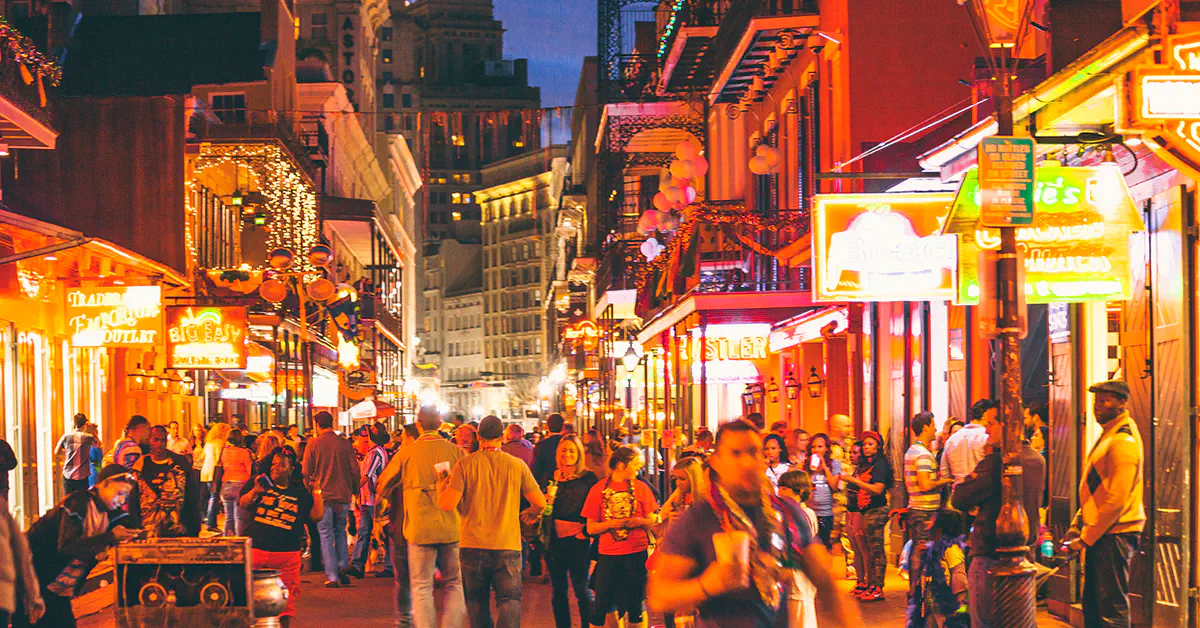Louisiana Drug Abuse, Addiction and Drug Rehab

There’s no corner of America that is free from drug and alcohol addiction. The State of Louisiana decided to take this threat seriously and, in 2017, launched a major program to reduce further losses from drug and alcohol use. At that time, the state was losing roughly 1,000 lives per year to drug overdoses but in the fall of 2019, that began to change and not in the way state officials hoped.
Despite the efforts of many well-intentioned people who wanted to bring these losses down, the loss of life began to climb. By February 2022, they had more than doubled.1 The major culprit in this loss of life was the powerful opioid illicitly manufactured fentanyl, just as it is in most other states.2
Among Louisianans, 7% struggle with drug addiction each year. If you select out the group of people aged 18 to 24 who are typically the most frequent users of drugs, the percentage goes up to 15%.3
The Need for Drug Rehab in Louisiana
There are drug rehab centers scattered all over the state, with groupings in Shreveport, Monroe, Alexandria, Lafayette, Baton Rouge, and, of course, New Orleans. While Louisiana has more than 200 of these facilities, many of the people who need help aren’t getting it. More than 15% of those aged 12 and older have a substance use disorder, but 40% of the people who need help are not able to get it.3

In the age group 18 to 25, 22% suffer from a substance use disorder and more than half don’t get help. This is the age group that most frequently indulges in drug abuse.
Choices for Drug Rehabilitation
When a family seeks help for an addicted loved one, they have several choices. Their choices start at hospitals and end with community support groups. Here are some of the types of drug rehabs these families might find.
-
Hospitals: Some people will need a hospital stay to begin their rehabilitation to keep them safe and healthy. A medical detox may be run in a hospital or in a facility dedicated to offering medical detox. During this type of detox, a person has around-the-clock medical supervision and support. For a person addicted to alcohol or benzodiazepines or who is in poor health, this kind of support may be essential. Other people may choose a medical detox to taper them off the drugs they had been abusing without their having to experience the worst of withdrawal symptoms.
-
Inpatient programs: These are residential facilities that also supervise those in recovery around the clock. Many of these programs are short-term, lasting only 30 days or so. Some, however, last longer which gives a person a chance to address and restructure their life for their best chance at success. Addiction often goes on for years or even decades—it can be challenging to make enough change in 30 days to formulate a new sober life. Inpatient programs should include life skills training to enable a person to begin to think differently about themselves and the people around them.
-
Outpatient programs: Some of these programs are intensive, with many hours per week devoted to meetings or counseling. An outpatient program enables a person to continue living at home during the program. A person starting an outpatient program needs to have a stable, safe place to live and supportive family or friends.
-
Therapeutic community: These are often funded by charities and managed by the people who live in them. Members typically have chores, help run the meetings and sometimes are required to take on jobs within or outside the community.
-
Community support groups: Alcoholics Anonymous is a type of organized community support group that offers structure and guidance for those in recovery. There are many of these Twelve Step programs oriented to different types of drug abuse, not just alcohol.
The type of program that is best for a person may depend on the family’s resources, the social skills of the individual in recovery and their willingness to put in the work to build a new life.
The Drug Threat in Louisiana
What are the primary drugs that create problems in Louisiana? Listed by the severity of the threat they pose, these are:

-
Methamphetamine: As it does in most regions, methamphetamine creates problems beyond the drug use and addiction that results. Higher levels of crime and violence accompany methamphetamine distribution anywhere it appears. Supplies come from Mexico; purity is high and the price is low. The methamphetamine problem has been increasing in the last several years, with the number of people arriving in drug rehab for help with meth addiction doubling in just two years.4
-
Illicitly manufactured fentanyl: The threat from fentanyl has been increasing, as demand for it increases. Along with fentanyl distribution, there is always the danger of fatal overdose because of the potency of this drug. Fentanyl is often found in counterfeit prescription drugs. What this means is that drug dealers purchase pill presses and manufacture their own pills that resemble OxyContin, Vicodin, Adderall and Xanax. But instead of the pharmaceutical drug people expect, they are getting potent doses of fentanyl.
-
Heroin: Like methamphetamine, the distribution of heroin tends to be accompanied by violence. Most heroin supplies are also contaminated with fentanyl, increasing the risk of fatal overdose. New Orleans is a source city for Mississippi and other areas of Louisiana.
-
Prescription drugs: The demand and availability for controlled prescription drugs are high in this region. This problem is increasing in most areas of the Gulf Coast.
-
Marijuana: Along with methamphetamine, this is the drug most in demand. Marijuana originating in California, Texas, and Colorado is often found in Louisiana, plus there are many outdoor and indoor grows in the state.
-
Cocaine: A persistent problem and also a contributor to violent crime in the area. Cocaine comes into the area in private vehicles via the Interstate system, package services, and boats operated by Mexican drug trafficking organizations.
-
New psychoactive substances: The substances included in this category are synthetic drugs like “bath salts,” MDMA (ecstasy), hallucinogens, inhalants, and anabolic steroids.
Rising Overdose Deaths Point Out the Danger of Drug Abuse
By taking a longer view of the loss of life to drug overdoses, it is possible to see that these deaths have not just doubled as mentioned earlier, they have more than tripled in a slightly longer period of time. In January 2015, there had been 782 overdose deaths in the prior 12 months. But by January 2022, there had been 2,501 deaths in the prior 12-month period. Over that entire seven-year period, the death toll accumulated to nearly 11,000.1
In addition to drug losses, more than 200 people per year lose their lives in alcohol-related driving fatalities.5
It will take much work to reverse this loss. It will mean finding effective rehabilitation for those who lost their way and offering both adults and children advice on avoiding drug abuse that they can really use. It will take the efforts of many families and dedicated people in drug rehabs, support groups and medical facilities across the state.
Sources:
-
CDC. “Provisional Drug Overdose Death Counts.” CDC, 2022. CDC. ↩︎ ↩︎
-
Louisiana Department of Health. “Louisiana Department of Health Reporting Surge of Fatal Drug Overdoses.” Louisiana DOH, 2021. DOH Publication. ↩︎
-
Substance Abuse and Mental Health Services Administration. “2019-2020 National Survey on Drug Use and Health: Model-Based Prevalence Estimates.” SAMHSA 2021. SAMHSA Publication. ↩︎ ↩︎
-
Gulf Coast High Intensity Drug Trafficking Area. “2021 Drug Threat Assessment.” GCHIDTA, 2020. GCHIDTA Publication ↩︎
-
Responsibility.org. “National Drunk Driving Statistics Map.” Responsibility.org, 2021. Responsibility.org ↩︎
